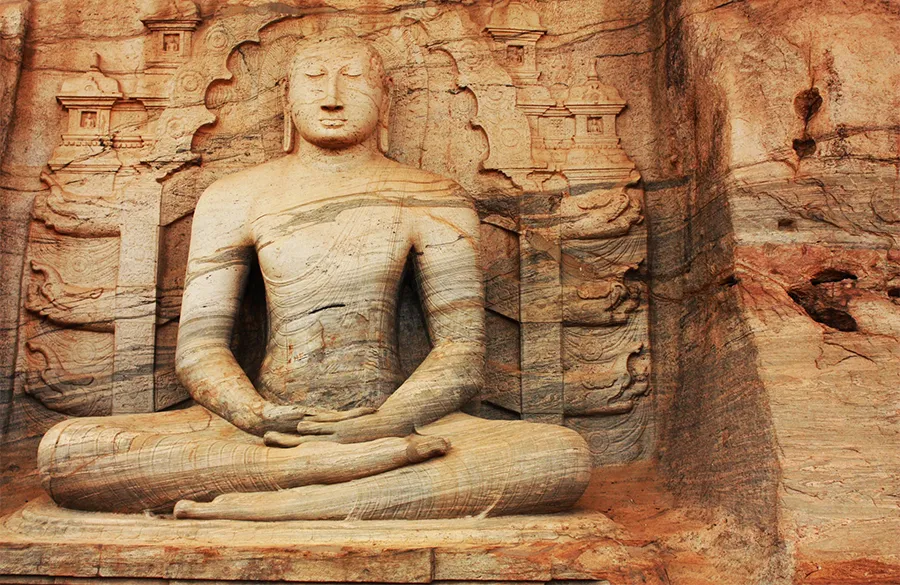Mahamudra is one of the most advanced teachings of the Buddha.
Mahamudra is composed of two Sanskrit words, maha, and mudra. Maha is easy to translate: it means “great” or “big.” Mudra has many different meanings: sign, symbol, gesture, seal, and so on. Mahamudra can be translated as “great seal,”, significant because it is a seal that marks all of the experience. “Seal” here is the true nature, emptiness and non-self-existence, non-duality.
The preliminary practices – Ngöndro – are required before entering Mahamudra. A qualified teacher’s advice and guidance are considered very important in developing faith and interest in the dharma and learning and practicing Mahamudra meditation. In Mahamudra practice, we go beyond the existence that we get used to thinking is real and ultimate. It is challenging to express what Mahamudra meditation is. It is beyond words, concepts, feelings. It’s beyond arising and beyond cessation.
Mahamudra meditation’s distinctive characteristic is that it focuses on the mind itself and its intimate relation with the world of conventional appearances and with emptiness. Karma Kagyu Mahamudra meditation focuses on the connection between mind and appearances from the point of view of their non-duality – neither can be established as existing on its own, separately from the other. Both exist beyond words and concepts because neither exists as findable objects inside the box-like categories that correspond to terms or concepts.
Tantra & Sutra Mahamudra practice
Tantric Mahamudra practices involve practicing deity yoga with yidam and subtle body practices like the six yogas of Naropa and can only be done after empowerment. After the preliminary practices, the Kagyu school’s sutra Mahamudra practice is often divided into ordinary or essential meditation practices and extraordinary meditation practices. The usual methods are Samatha (calming) and vipassana (unique insight). The extraordinary techniques include “formless” practices like ‘one taste yoga’ and ‘non-meditation.’
Mahamudra is emptiness. It is the experience of emptiness rather than explaining what it means. Even if you know all the Buddhist texts and understand them intellectually, it will never touch your heart unless you meditate.
Mahamudra Vipassana Meditation
Tibetan Buddhism
-
- Start with a proper posture — the seven point posture of Vairocana.
- Direct your eyes, intensely wide-open, straight ahead at the center of the empty space before you, without blinking, or fluttering, and gaze.
- Settling of your mind (see Samatha meditation), set your mind tranquilly into its natural mode. Keep your mindfulness on the ever-present moment, vividly transparent, wide awake, and without meandering.
- Wangchuck Dorje gives ten separate contemplations that are used to disclose the essential mind within; five practices of “looking at” and five of “pointing out” the nature of mind.
The five practices for “looking at” the nature of the mind are:
- Looking at the settled mind. One repeatedly looks at the mind’s still state, possibly posing questions to arouse awareness, such as “what is its nature? It is perfectly still?”
- Looking at the moving or thinking mind. One tries to closely examine the arising, existence, and ceasing of thoughts, possibly posing oneself questions so as to better understand this process, such as “how does it arise? What is its nature?”
- Looking at the mind reflecting appearances. One looks at the way in which phenomena of the external senses occur in experience. Usually, a visual object is taken as the subject. One repeatedly looks at the object, trying to see just how that appearance arises in the mind, and understand the nature of this process. One possibly asks questions such as “what is their nature? How do they arise, dwell, and disappear? Is their initial appearance different from how they eventually understood?”
- Looking at the mind in relation to the body. One investigates questions such as “what is the mind? What is the body? Is the body our sensations? What is the relation of our sensations to our mental image of our body?”
- Looking at the settled and moving minds together. When the mind is still, one looks at that, and when the mind is in motion, one looks at that. One investigates whether these two stages are the same or different, asking questions such as “if they are the same, what is the commonality? If different, what is the difference?”
The practices for “pointing out the nature of mind” build on these. One now looks again at each of the five, but this time repeatedly asks oneself “What is it?” In these practices, one attempts to recognize and realize the exact nature of, respectively:
- The settled mind,
- The moving or thinking mind,
- The mind reflecting appearances,
- The relation of mind and body,
- The settled and thinking mind together.
*DO NOT practice without a teacher and empowerment
Meditation in Dzogchen – click here




